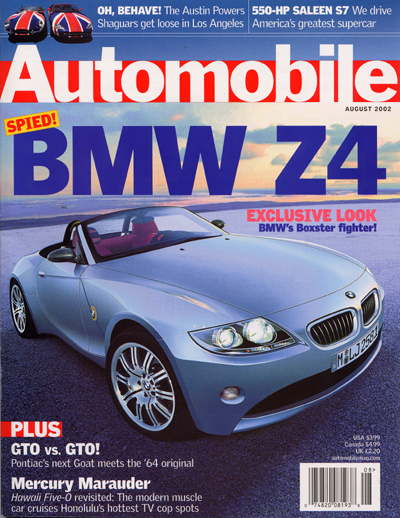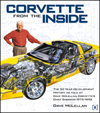|
Corvette From the Inside
Price: $49.95
|
Automobile August, 2002

review by David E. Davis, Jr.
Kicking off the Festivities
Two great books initiate the Corvette's fiftieth-anniversary celebration.
I suppose I need three or four Corvettes. I definitely want a 1962 production-racing Vette with all the serious-racer RPOs and a hard top. The sharp edge around the tail presaged the Sting Ray and conveyed some serious attitude, and the '62 was cleaner and less busy than the '61.
The front isn't beautiful, and the interior is garish, but this is a real car! I have driven such a Corvette, and it is probably too stiff for the street, but it is a lovely, predictable, stab-it-and-steer-it kind of American sports car.
Next, I would require a 1965 Sting Ray coupe with the L79 350-horsepower, 327-cubic-inch engine; the long 2.20:1 first gear; and the 3.36:1 Positraction read end. The 350-horse L79 engine featured hydraulic lifters, while the more powerful (375-horsepower) version came with solid lifters and could thus be more easily damaged by an excess of enthusiasm. To the obsessive zealots in the National Corvette Restorers Society, these are the "Mid-Year" cars, but to me they are the most beautiful Corvettes ever built, unless we count Bill Mitchell's Sting Ray racing car of the late '50s. Zora Arkus-Duntov hated these cars because they were created by his enemy Mitchell, director of GM Styling, during the time when Arkus-Duntov was bewitched by his own ghastly CERV experimental vehicles.
I will mercifully limit mention of the 1968-82 Corvettes, which were ugly and cramped and suffered from egregious quality problems. They were also the Corvettes that took the full hit when our government got into the car business and began to micromanage emissions performance. The famously fast L88 definied this generation of Vettes, but the cars were junk, and we really didn't care how fast they went.
My third choice comes from author and chief engineer Dave McLellan's era, and it's the Corvette ZR-1. The ZR-1 was probably a dumb idea, and its Lotus-designed and Mercury Marine-built LT-5 DOHC V-8 proved to be far too expensive for the target market, who never understood what all the ZR-1 fuss was about anyway. But the car itself was a very sweet high-performance two-seater-probably the best and most ambitious Corvette since the very beginning in 1953. Mercury Marine built the last LT-5 engine in 1993, and the ZR-1 itself suffered a quiet death in 1995. I was present at the ZR-1's debut in Geneva in 1989, and the drive from Geneva to Carcassone in the south of France was as perfect a driving experience as I've known.
The fourth and last Corvette on my wish list is the current, fifth-generation coupe. The C5 Corvette is the best in history, better even than the $60,000 ZR-1, and it proves very quickly that pushrod-driven valvetrains are not obsolete at all. The C5 is powered by a third-generation version of the original small-block Chevy V-8, and it is a mechanical wonder. I choose the hatchback coupe over the Z06 or the convertible because this car would be my daily driver, and the coupe is more accommodating to people and stuff than either of the others. I'm not fond of the whopping great tail on the C5, but I'm crazy about the rear suspension, wide tires, and vast luggage space. I'd like my C5 to look as much like the yellow C5-R racing cars as possible. I have seen them run successfully several times, and they join the long list of things that make me proud to be an American.
Jerry Burton's book, Zora Arkus-Duntov:The Legend behind Corvette, is a comprehensive and carefully researched biography of Zora Arkus-Duntov, warts and all, who will be forever described as "the father of the Corvette." The Corvette had several other fathers, but it is Zora who gets the credit from the press and from the adoring multitudes of Corvette owners. The Corvette was, effectively, Arkus-Duntov's leit-motif in the second half of his long and colorful career, and he was-to the day he died-a tireless and incorrigible self-promoter. Burton, the editorial director of Corvette News, was as close to Zora as anyone in the last years of Arkus-Duntov's life, and that constant contact made it difficult for the author to establish some needed critical distance from his subject-indeed, even to complete the manuscript. But his book is a good one and will correct a lot of misconceptions about Arkus-Duntov while it adds to his legend.
Dave McLellan's Corvette from the Inside is equally thorough in its study of Corvette history-particularly during the era when he was an active participant-and thus becomes an ideal companion for Burton's Arkus-Duntov biography. If McLellan's book seems a bit dry, the reader is advised to consider the source. Apparently, the most fun engineer McLellan ever had was the ZR-1 press launch in Geneva, and this falls a bit shy of Arkus-Duntov, who seemed determined to have fun every day of his life, sometimes whith two or three different women.


![[B] Bentley Publishers](http://assets1.bentleypublishers.com/images/bentley-logos/bp-banner-234x60-bookblue.jpg)
